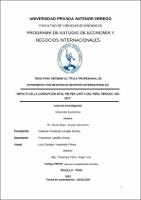Impacto de la corrupción en el PBI Per Cápita del Perú, periodo 1981 2021
Resumen
La investigación lleva como título “El impacto de la corrupción en el Producción
bruto interno per cápita del Perú, periodo 1981-2021” el cual pretende investigar el
impacto de la corrupción en el PBI per cápita del Perú durante el periodo 1981–
2021, basado en diversas teorías que relacionan la corrupción y PBI per cápita.
Para este estudio se empleó el modelo de disgregación de la corrupción definido
por Mendoza (2000), el cual sostiene cómo el desarrollo de la corrupción afecta el
ingreso del individuo.
Estimando un modelo econométrico con datos del “Índice de la Corrupción”
(Corrupción) y “Producto Bruto Interno per Cápita” (Ingreso por individuo) obtenidos
de la base de datos de la Transparencia Internacional y del Banco Central de
Reserva del Perú (BCRP), en la que la variable dependiente es el Producto Bruto
Interno per Cápita y la variable independiente es el del Índice de la Corrupción.
En conformidad con los resultados obtenidos, se demuestra que la corrupción es
significativa para explicar el producto bruto interno per cápita, es decir, que el
producto bruto interno per cápita responde al comportamiento del índice de la
corrupción.
Concluyendo que la corrupción impacta negativamente en el producto bruto interno
per cápita. The investigation is entitled ““The impact of corruption on the per capita gross
domestic production of Peru, period 1981-2021““ which aims to investigate the
impact of corruption on the GDP per capita of Peru during the period 1981-2021,
based on in various theories that relate corruption and GDP per capita. For this
study, the corruption breakdown model defined by Mendoza (2000) was used, which
maintains how the development of corruption affects the income of the individual.
Estimating an econometric model with data from the ““Corruption Perception Index““
(Corruption) and ““Gross Domestic Product per Capita““ (Income per individual)
obtained from the database of Transparency International and the Central Reserve
Bank of Peru (BCRP), in which the dependent variable is the Gross Domestic
Product per Capita and the independent variable is the Corruption Perception Index.
In accordance with the results obtained, it is shown that corruption is significant to
explain the gross domestic product per capita, that is, that the gross domestic
product per capita responds to the behavior of the corruption index.
Concluding that corruption has a negative impact on the gross domestic product per
capita.
Palabras clave
Colecciones
- Economía y Finanzas [87]


